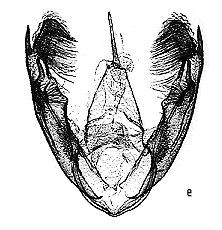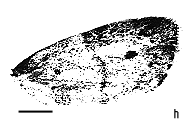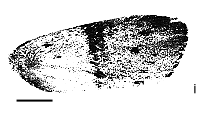|
Stictane muara sp.
n.

Fig. 8d:
(aedeagus)

Fig. 8e:
Stictane muara sp.n.
(male
genitalia)
|

Fig. 9h:
Stictane
sp. ? muara sp.n.
(slide 4923)

Fig. 9i:
Stictane
muara sp.n.
(slide 4928)
|

|
♂♂,
♀♀
5mm.
The male antennae are serrate to narrowly bipectinate with dense ciliae, but the
facies is otherwise much as in ciliata except
the medial fascia has a fainter second fascia just distad and parallel. The male
genitalia are distinctive in having a marginal, straight, subapical spine
distally to the more sinuous saccular one, flanking the densely setose cucullus.
The aedeagus vesica (not everted) has numerous cornuti. The female genitalia
have a broad corpus bursae and a long, reflexed appendix bursae. There are
fields of long spines in the basal, slightly sclerotised part of the appendix,
and a few also in the neck of the ductus. There is a finer scobination of
shorter spines in the distal part of the corpus bursae.
Holotype
♂.BRUNEI: 1m, 3km WSW of
Muara, Kampong Kapok, edge of mangrove
forest, I-ii. 1992 (E. W. Classey), BM
arctiid slide 5473.
Paratypes:
2♂♂ as
holotype.
Other
material: 1♀
as holotype, 1♀ (slide 4923)
SABAH: 5m. S. Mt. Trus Madi, 1800 ft. 18-28.viii.
1977; 1♀ (slide 4928) BRUNEI:
Seria, 2� forest, 30m. iv. 1981 (I.
Gauld).
Geographical
range. Borneo.
Habitat
preference. All
males are from near mangrove on the coast. Single females were taken at the type
locality, at 30m in disturbed forest at Seria near the Brunei coast (slide
4928), and in primary forest at 600m on G. Trus Madi in Sabah (slide 4923). The
forewings of these last two females are illustrated in Figs9h, i, that from
Seria having more typical facies.
<<Back
>>Forward <<Return
to Contents page
|

